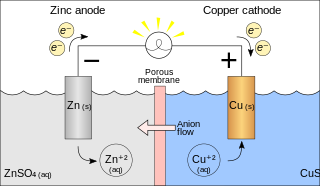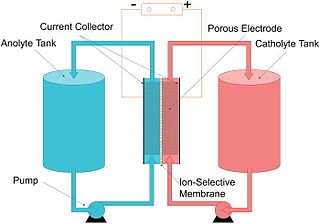Related Research Articles
Electrochemistry is the branch of physical chemistry concerned with the relationship between electrical potential difference and identifiable chemical change. These reactions involve electrons moving via an electronically-conducting phase between electrodes separated by an ionically conducting and electronically insulating electrolyte.

An electrode is an electrical conductor used to make contact with a nonmetallic part of a circuit. Electrodes are essential parts of batteries that can consist of a variety of materials depending on the type of battery.

A galvanic cell or voltaic cell, named after the scientists Luigi Galvani and Alessandro Volta, respectively, is an electrochemical cell in which an electric current is generated from spontaneous Oxidation-Reduction reactions. A common apparatus generally consists of two different metals, each immersed in separate beakers containing their respective metal ions in solution that are connected by a salt bridge or separated by a porous membrane.
A primary battery or primary cell is a battery that is designed to be used once and discarded, and not recharged with electricity and reused like a secondary cell. In general, the electrochemical reaction occurring in the cell is not reversible, rendering the cell unrechargeable. As a primary cell is used, chemical reactions in the battery use up the chemicals that generate the power; when they are gone, the battery stops producing electricity. In contrast, in a secondary cell, the reaction can be reversed by running a current into the cell with a battery charger to recharge it, regenerating the chemical reactants. Primary cells are made in a range of standard sizes to power small household appliances such as flashlights and portable radios.

Zinc–air batteries (non-rechargeable), and zinc–air fuel cells are metal–air batteries powered by oxidizing zinc with oxygen from the air. These batteries have high energy densities and are relatively inexpensive to produce. Sizes range from very small button cells for hearing aids, larger batteries used in film cameras that previously used mercury batteries, to very large batteries used for electric vehicle propulsion and grid-scale energy storage.

A zinc–carbon battery (or carbon zinc battery in U.S. English) is a dry cell primary battery that provides direct electric current from the electrochemical reaction between zinc (Zn) and manganese dioxide (MnO2) in the presence of an ammonium chloride (NH4Cl) electrolyte. It produces a voltage of about 1.5 volts between the zinc anode, which is typically constructed as a cylindrical container for the battery cell, and a carbon rod surrounded by a compound with a higher Standard electrode potential (positive polarity), known as the cathode, that collects the current from the manganese dioxide electrode. The name "zinc-carbon" is slightly misleading as it implies that carbon is acting as the oxidizing agent rather than the manganese dioxide.

A flow battery, or redox flow battery, is a type of electrochemical cell where chemical energy is provided by two chemical components dissolved in liquids that are pumped through the system on separate sides of a membrane. Ion transfer inside the cell occurs through the membrane while both liquids circulate in their own respective space. Cell voltage is chemically determined by the Nernst equation and ranges, in practical applications, from 1.0 to 2.43 volts. The energy capacity is a function of the electrolyte volume and the power is a function of the surface area of the electrodes.
A zinc–bromine battery is a rechargeable battery system that uses the reaction between zinc metal and bromine to produce electric current, with an electrolyte composed of an aqueous solution of zinc bromide. Zinc has long been used as the negative electrode of primary cells. It is a widely available, relatively inexpensive metal. It is rather stable in contact with neutral and alkaline aqueous solutions. For this reason it is used today in zinc–carbon and alkaline primaries.

Nanobatteries are fabricated batteries employing technology at the nanoscale, particles that measure less than 100 nanometers or 10−7 meters. These batteries may be nano in size or may use nanotechnology in a macro scale battery. Nanoscale batteries can be combined to function as a macrobattery such as within a nanopore battery.

Lithium iron phosphate or lithium ferro-phosphate (LFP) is an inorganic compound with the formula LiFePO
4. It is a gray, red-grey, brown or black solid that is insoluble in water. The material has attracted attention as a component of lithium iron phosphate batteries, a type of Li-ion battery. This battery chemistry is targeted for use in power tools, electric vehicles, solar energy installations and more recently large grid-scale energy storage.

A lithium-ion capacitor is a hybrid type of capacitor classified as a type of supercapacitor. It is called a hybrid because the anode is the same as those used in lithium-ion batteries and the cathode is the same as those used in supercapacitors. Activated carbon is typically used as the cathode. The anode of the LIC consists of carbon material which is often pre-doped with lithium ions. This pre-doping process lowers the potential of the anode and allows a relatively high output voltage compared to other supercapacitors.
The lithium–air battery (Li–air) is a metal–air electrochemical cell or battery chemistry that uses oxidation of lithium at the anode and reduction of oxygen at the cathode to induce a current flow.
A metal–air electrochemical cell is an electrochemical cell that uses an anode made from pure metal and an external cathode of ambient air, typically with an aqueous or aprotic electrolyte.
A potassium-ion battery or K-ion battery is a type of battery and analogue to lithium-ion batteries, using potassium ions for charge transfer instead of lithium ions. It was invented by the Iranian/American chemist Ali Eftekhari in 2004.

Sodium-ion batteries (NIBs or SIBs) are several types of rechargeable batteries, which use sodium ions (Na+) as its charge carriers. In some cases, its working principle and cell construction are similar to those of lithium-ion battery (LIB) types, but it replaces lithium with sodium as the cathode material. Sodium belongs to the same group in the periodic table as lithium and thus has similar chemical properties. In other cases, aqueous Na-ion batteries are quite different from Li-ion batteries.
Aluminium-ion batteries are a class of rechargeable battery in which aluminium ions serve as charge carriers. Aluminium can exchange three electrons per ion. This means that insertion of one Al3+ is equivalent to three Li+ ions. Thus, since the ionic radii of Al3+ (0.54 Å) and Li+ (0.76 Å) are similar, significantly higher numbers of electrons and Al3+ ions can be accepted by cathodes with little damage. Al has 50 times (23.5 megawatt-hours m-3) the energy density of Li and is even higher than coal.
Research in lithium-ion batteries has produced many proposed refinements of lithium-ion batteries. Areas of research interest have focused on improving energy density, safety, rate capability, cycle durability, flexibility, and cost.
Magnesium batteries are batteries that utilize magnesium cations as the active charge transporting agents in solution and often as the elemental anode of an electrochemical cell. Both non-rechargeable primary cell and rechargeable secondary cell chemistries have been investigated. Magnesium primary cell batteries have been commercialised and have found use as reserve and general use batteries.
Multivalent batteries are energy storage and delivery technologies (i.e., electro-chemical energy storage) that employ multivalent ions, e.g., Mg2+, Ca2+, Zn2+, Al3+ as the active charge carrier in the electrolytes as well as in the electrodes (anode and cathode). Multivalent batteries are generally pursued for the potentially greater capacity, owing to greater ion valency, as well as natural mineral abundance.

This is a history of the lithium-ion battery.
References
- ↑ "A cheap, long-lasting, sustainable battery for grid energy storage | KurzweilAI". www.kurzweilai.net. 2016-09-16. Retrieved 2017-02-02.
- 1 2 3 4 Ma, Lin; Schroeder, Marshall A.; Borodin, Oleg; Pollard, Travis P.; Ding, Michael S.; Wang, Chunsheng; Xu, Kang (2020). "Realizing high zinc reversibility in rechargeable batteries". Nature Energy. 5 (10): 743–749. Bibcode:2020NatEn...5..743M. doi:10.1038/s41560-020-0674-x. ISSN 2058-7546. S2CID 221118342.
- ↑ US 20120034515,Kang, Feiyu; XU, Chengjun& Li, Baohua,"Rechargeable zinc ion battery",published Feb 9, 2012
- ↑ Xu, Chengjun; Li, Baohua; Du, Hongda; Kang, Feiyu (2012-01-23). "Energetic Zinc Ion Chemistry: The Rechargeable Zinc Ion Battery". Angewandte Chemie International Edition. 51 (4): 933–935. doi:10.1002/anie.201106307. ISSN 1521-3773. PMID 22170816.
- ↑ Kundu, Dipan; Vajargah, Shahrzad Hosseini; Wan, Liwen; Adams, Brian; Prendergast, David; Nazar, Linda F. (April 18, 2018). "Aqueous vs. nonaqueous Zn-ion batteries: consequences of the desolvation penalty at the interface". Energy & Environmental Science. 11 (4): 881–892. doi:10.1039/C8EE00378E. OSTI 1469689 – via pubs.rsc.org.
- ↑ "University of Waterloo Salient Energy". CBC.
- ↑ "Power up: Halifax's thriving battery scene attracts Ontario startup". Dalhousie News.
- ↑ "Stakeholder Consultation of the Energy Storage Partnership (ESP) November 18, 2020 | ESMAP". esmap.org. Retrieved 2022-03-20.
- ↑ "Home". Eos Energy Enterprises.
- ↑ "1.5GWh of 'Made in America' zinc batteries joining Texas, California grids from Eos Energy Storage". Energy Storage News. 1 Sep 2020.
- 1 2 Ma, Lin; Schroeder, Marshall A.; Pollard, Travis P.; Borodin, Oleg; Ding, Michael S.; Sun, Ruimin; Cao, Longsheng; Ho, Janet; Baker, David R.; Wang, Chunsheng; Xu, Kang (2020). "Critical Factors Dictating Reversibility of the Zinc Metal Anode". Energy & Environmental Materials. 3 (4): 516–521. doi: 10.1002/eem2.12077 . ISSN 2575-0356.
- ↑ Alfaruqi, Muhammad H.; Mathew, Vinod; Gim, Jihyeon; Kim, Sungjin; Song, Jinju; Baboo, Joseph P.; Choi, Sun H.; Kim, Jaekook (2015-05-26). "Electrochemically Induced Structural Transformation in a γ-MnO2 Cathode of a High Capacity Zinc-Ion Battery System". Chemistry of Materials. 27 (10): 3609–3620. doi:10.1021/cm504717p. ISSN 0897-4756.
- ↑ Alfaruqi, Muhammad Hilmy; Gim, Jihyeon; Kim, Sungjin; Song, Jinju; Pham, Duong Tung; Jo, Jeonggeun; Xiu, Zhiliang; Mathew, Vinod; Kim, Jaekook (2015). "A layered δ-MnO 2 nanoflake cathode with high zinc-storage capacities for eco-friendly battery applications". Electrochemistry Communications. 60: 121–125. doi:10.1016/j.elecom.2015.08.019.
- ↑ Trócoli, Rafael; La Mantia, Fabio (2015-02-01). "An Aqueous Zinc-Ion Battery Based on Copper Hexacyanoferrate". ChemSusChem. 8 (3): 481–485. doi:10.1002/cssc.201403143. ISSN 1864-564X. PMID 25510850.
- ↑ Kundu, Dipan; Adams, Brian D.; Duffort, Victor; Vajargah, Shahrzad Hosseini; Nazar, Linda F. (October 2016). "A high-capacity and long-life aqueous rechargeable zinc battery using a metal oxide intercalation cathode". Nature Energy. 1 (10): 16119. Bibcode:2016NatEn...116119K. doi:10.1038/nenergy.2016.119. OSTI 1469690. S2CID 99789580.